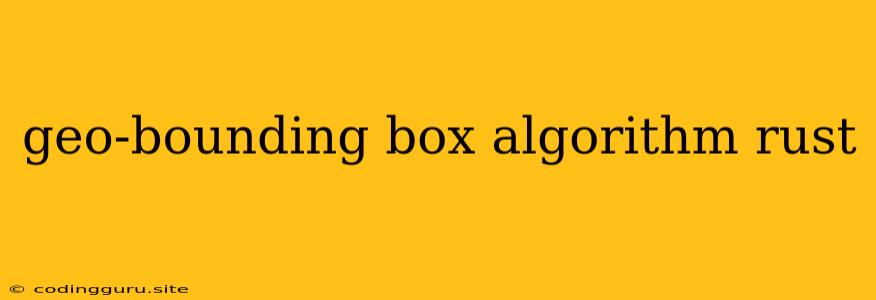Mastering Geo-Bounding Boxes: A Rust Developer's Guide
Geo-bounding boxes are fundamental for spatial queries and indexing in geographical applications. They provide a simple and efficient way to represent a rectangular area on the Earth's surface. This article will explore how to implement geo-bounding box algorithms in Rust, a powerful and efficient programming language.
Why Rust for Geo-Bounding Boxes?
Rust is a popular choice for developing high-performance and reliable systems. Its strong memory safety guarantees, ownership model, and powerful type system make it ideal for working with spatial data. Furthermore, Rust's thriving ecosystem offers a wide range of crates dedicated to geospatial computations, making it a perfect tool for building geo-bounding box functionalities.
Understanding Geo-Bounding Boxes
A geo-bounding box is defined by two points: the southwestern corner (minimum longitude and latitude) and the northeastern corner (maximum longitude and latitude). This rectangle encloses all the points within its boundaries.
Creating Geo-Bounding Boxes in Rust
Let's dive into the code. We'll use the geo crate, a popular Rust library for geospatial calculations:
use geo::{Point, Rect};
fn main() {
// Define the southwestern and northeastern corners of the bounding box.
let south_west = Point::new(10.0, 20.0);
let north_east = Point::new(30.0, 40.0);
// Create a geo-bounding box using the corners.
let bounding_box = Rect::new(south_west, north_east);
// Print the bounding box.
println!("{:?}", bounding_box);
}
This code creates a bounding box with the southwestern corner at (10.0, 20.0) and the northeastern corner at (30.0, 40.0). The Rect structure from the geo crate represents the bounding box.
Geo-Bounding Box Operations
Now let's look at some essential operations you can perform with geo-bounding boxes in Rust:
- Checking if a Point is Inside the Bounding Box:
use geo::{Point, Rect};
fn main() {
// Create a bounding box.
let bounding_box = Rect::new(Point::new(10.0, 20.0), Point::new(30.0, 40.0));
// Check if a point is inside the bounding box.
let point = Point::new(15.0, 25.0);
let is_inside = bounding_box.contains(&point);
println!("Point inside bounding box: {}", is_inside);
}
This code checks whether the point (15.0, 25.0) lies within the defined bounding box.
- Finding the Intersection of Two Bounding Boxes:
use geo::{Point, Rect};
fn main() {
// Create two bounding boxes.
let bounding_box1 = Rect::new(Point::new(10.0, 20.0), Point::new(30.0, 40.0));
let bounding_box2 = Rect::new(Point::new(20.0, 30.0), Point::new(40.0, 50.0));
// Find the intersection of the two bounding boxes.
let intersection = bounding_box1.intersection(&bounding_box2);
// Print the intersection.
println!("{:?}", intersection);
}
This code calculates the overlapping area between two bounding boxes.
Real-World Applications
Geo-bounding boxes are crucial in a variety of geospatial applications, including:
- Spatial Indexing: Efficiently indexing and querying spatial data like points, polygons, and lines.
- Map Rendering: Determining which features to display based on the current viewport.
- Location-Based Services: Finding nearby places, filtering results based on location, and performing proximity searches.
Conclusion
Implementing geo-bounding boxes in Rust is straightforward and beneficial for building efficient geospatial applications. The geo crate provides a powerful set of tools for creating, manipulating, and analyzing bounding boxes. Remember, the key to successful spatial data management lies in understanding these foundational concepts and leveraging the right tools for the job.
